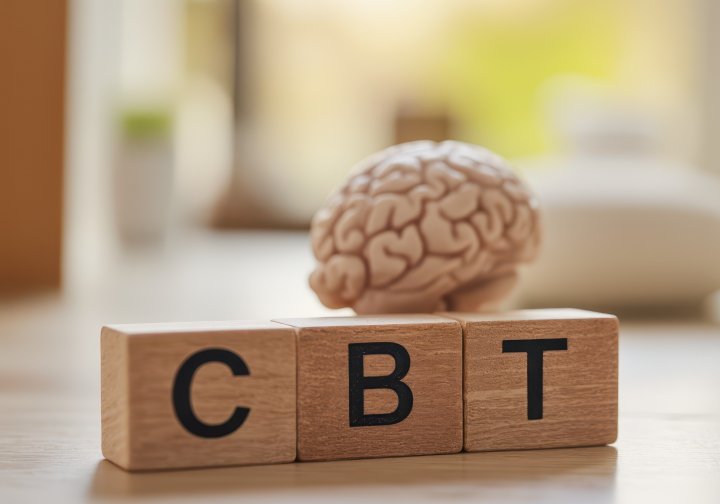Blog

Cognitive-behavioral therapy (CBT): When change begins in thinking
Cognitive behavioral therapy (often referred to as CBT) is one of the most scientifically researched and most commonly used psychotherapeutic approaches. It originated in the 1960s in an effort to combine the techniques of behaviorism (a psychological approach focused on the study of behavior and the influence of learning) with the principles of cognitive psychology (a discipline that examines mental cognitive processes such as perception, memory, and thinking). The National Institute of Health defines CBT as a combination of cognitive and behavioral therapy, emphasizing the interaction between thoughts, emotions, and behaviors.
Basic principles of CBT
CBT is based on the assumption that our thoughts, emotions, and behaviors are interconnected. Founder Aaron Beck and his colleagues described three basic levels of cognition that are key in CBT practice:
- Automatic thoughts – spontaneous, mostly internal reflections that quickly appear in the flow of everyday thinking and are usually accepted unconsciously without examining whether they are accurate or relevant.
- e.g. If a person thinks, "They're ignoring me because they don't like me," they may feel hurt and start avoiding the other person. However, if they say to themselves, "They were in a hurry and didn't have time," their emotional reaction will be calmer.
- Cognitive distortions – systematic errors in thinking that lead to an inaccurate perception of reality.
- e.g. dichotomous (black-and-white) thinking – seeing things only as "success/failure," overgeneralization – applying one experience to all situations.
- Underlying beliefs – they take shape as we go through life experiences and influence how we understand ourselves and the world.
- e.g. "To be accepted, I must be perfect."
- Working with schemas is often key to lasting change, as restructuring them helps prevent difficulties from returning.
Structure and course of therapy
The aim of CBT is to determine whether certain learned behaviors contribute to the worsening of difficulties. Subsequently, the client and therapist focus on changing these behaviors and learning new, more functional strategies. Structured techniques are used for this purpose, such as:
- Cognitive restructuring – recognizing and questioning automatic thoughts and cognitive distortions, replacing them with more realistic and balanced interpretations.
- Exposure – gradually exposing oneself to feared stimuli or situations with the support of a therapist, thereby reducing anxiety and eliminating maladaptive responses.
- Skills training – practicing specific coping strategies or relaxation techniques.
- Homework – between sessions, the client actively practices new ways of thinking and behaving, thereby reinforcing the effect of therapy.
This helps clients to understand their reactions and develop more effective ways of coping with difficulties. Therapy is usually short-term and clearly structured. It typically consists of approximately 10 to 20 sessions, during which the therapist and client jointly set specific goals that can be monitored and evaluated throughout the course of therapy. Each session has a fixed framework: at the beginning, progress since the last meeting is summarized, followed by work on the main topic, practice of new strategies, and finally planning tasks for the following week.
Where CBT can help and why it is effective
Cognitive behavioral therapy is one of the approaches whose effectiveness is supported by extensive research. The American Psychological Association (APA) and the World Health Organization (WHO) recommend it as the first-line treatment for depression, anxiety disorders, post-traumatic stress disorder, and obsessive-compulsive disorder.
For example, a meta-analysis by Hofmann et al. (2012) analyzed 269 studies covering various disorders, from anxiety and depressive disorders to eating disorders, personality disorders, and problems with addiction and chronic pain. According to the review, the strongest scientific evidence exists for the treatment of anxiety disorders such as social phobia, panic disorder, and post-traumatic stress disorder. Significant effects have also been reported for depressive disorders, eating disorders (especially bulimia), insomnia, and chronic pain. CBT has also proven effective for accompanying mental health issues in physical illnesses, specifically in cancer patients or patients with multiple sclerosis.
It has been repeatedly confirmed that CBT leads to a significant reduction in symptoms and an improvement in quality of life across various diagnoses. However, the success of therapy also depends on the active cooperation of the client. CBT is based on a partnership between the therapist and the client, where the client learns to actively recognize their thoughts, understand them, and gradually change the way they respond to stressful situations.
Cognitive behavioral therapy at PSYMED is provided by psychotherapist Aaron Gil, MA. He received his education in clinical psychology in California and combines his experience from American psychological practice with a culturally sensitive approach to people in various life situations. You can read more about him on his profile.
If you are interested in cognitive-behavioral therapy and would like to make an appointment with psychotherapist Aaron Gil, please contact us.
About author: Jana FelklovaJana is a first-year master’s student in the Theoretical and Research Psychology program at Charles University in Prague. She views her work at Unicare Medical Center as a valuable opportunity to gain hands-on experience in the field of psychology while pursuing her studies. |
References:
Norcross, J. C., & Lambert, M. J. (2018). Psychotherapy relationships that work III. Psychotherapy, 55(4), 303.
National Center for Biotechnology Information. (2022). Cognitive Behavioral Therapy (CBT): Overview and Applications. In StatPearls [Internet]. Treasure Island (FL): StatPearls Publishing. Retrieved from https://www.ncbi.nlm.nih.gov/books/NBK470241/
Hofmann, S. G., Asnaani, A., Vonk, I. J. J., Sawyer, A. T., & Fang, A. (2012). The efficacy of cognitive behavioral therapy: A review of meta-analyses. Cognitive Therapy and Research, 36(5), 427–440. https://doi.org/10.1007/s10608-012-9476-1
